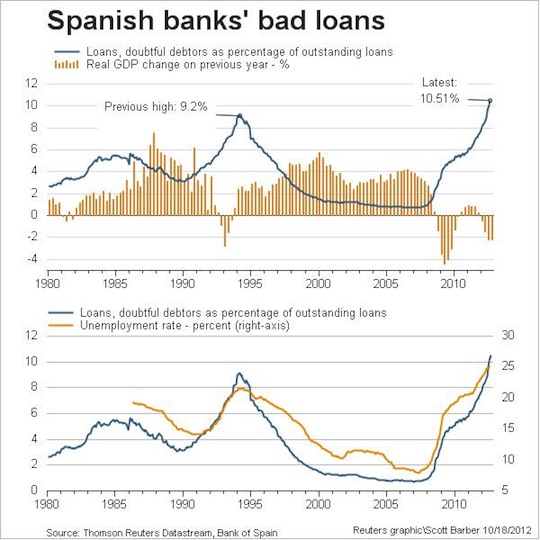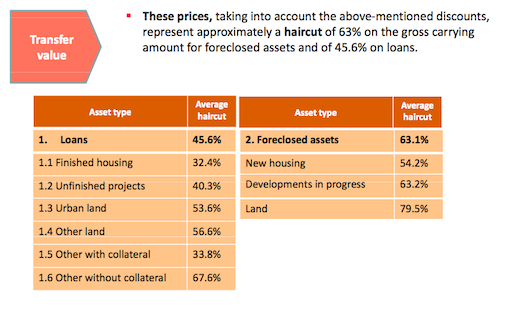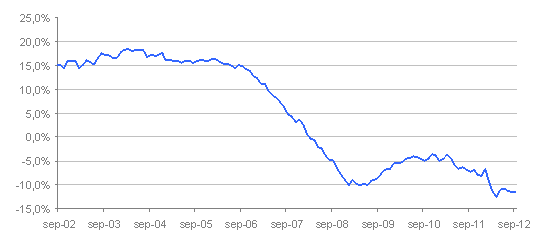It’s been well-known for some time that Spain’s banking system is steadily getting worse from the fallout of a popped real estate bubble and the on-going eurozone debt crisis. In June 2009 the “fund for orderly bank restructuring” was setup in order to facilitate a restructure of the Spanish banking system with the goal of bringing stability back to the financial system. However, since that time the state of the Spanish economy has worsened significantly and in May 2012 we saw the nationalisation of Bankia, Spain’s 3rd largest bank.
Bankia itself was a conglomerate of 7 banks born out of the crisis in July 2010 which was initially given a government injection, via the FROB, of €4.5bn. By May 2012 this had grown to over €20bn as it became clear that the bank was in a far worse state than previously known.
In the meantime the Spanish housing market has continued to collapse, which together with the outcomes of continued fiscal tightening and attempts at rapid private sectors deleveraging, has meant a sharp climb in bad debts within the Spanish banks.

Given the ongoing, and growing, issues the Spanish government announced earlier this year that it would be seeking external funding ( approx €100bn ) in order to support the banking system and as part of this process it was stated back in August that a “bad bank” would be created.
On Monday of this week the Spanish government announced the initial details of what it now known as “Sareb”. The points we know so far are:
- Sareb will be run as a “for profit” entity which will be owned by the FROB, along with private investors. Private investors are expected to take the majority share.
- Sareb will have 8% capital and its duration is expected to be 15 years.
- Sareb will purchase €90bn of distressed assets in two tranches. The first stage of €45bn will focus on already nationalised banks only.
- Sareb is expected to deliver 14-15% ROE
So the basic idea is that the “bad bank” will buy up distressed real estate assets from the banks with the aim of improving their balance-sheets and reducing any perceived and/or real risk about their sustainability. As you can see from the chart below there will be significant write-downs on value during the transfer.

These numbers may appear impressive but there are some fairly substantial issues. Of note is the “transfer value”:
The transfer price will be set on the basis of two different Transfer value components:
– The real economic value of the assets
– Additional adjustments by asset type as a result of the transfer of assets to Sareb due to aspects such as:En bloc acquisition of assets
- Coverage of certain risks of Sareb
- Consideration of certain expenses borne by banks’ income statements and which must now be assumed by the company
- And outlook for divestment of assets transferred to Sareb
-The transfer price is not a reference for the valuation of non‐ transferred bank assets.
Firstly, the last point seems unrealistic. According to recent statistics there are currently nearly 2 million houses for sale , another 2.5 million houses empty and further 1.3 million still under construction across Spain. Given this is a distressed market I don’t think there is any doubt that the write-down on assets transferred to Sareb will be seen as a baseline for existing values.
Secondly, loans on finished housing is being transferred at a write-down of 32.4%, yet the Tinsa housing index already shows a fall from peak of 32.9% and shows no signs of bottoming with current YoY falls at over 11%.
Tinsa Index YoY evolution.
Obviously not all distressed loans will be against property purchased at peak and LVRs will play their part, but even if you take a highly optimistic view that housing falls have bottomed, which I don’t, it will still be a number of years before prices begin to rise again. That being the case banks may still be holding loss-making assets even after the transferring of their most distressed assets. The “bad bank” itself would obviously see deteriorating asset values as well.
The other point is that large write-downs will force mark-t0-market across the whole economy. Banks “performing” assets, real estate holdings of the private sector and government tax revenues based on valuations are all likely to suffer further. Yes, it’s a cleansing exercise , but given the state of the economy in Spain at present a re-newed hit to asset values is of concern.
The big question is whether private sector investors will be interested in taking part. With the Spanish economy continuing to shrink, unemployment at record levels and future estimates looking very dour it’s quite an ask, although future external support for Spain may help.
A document explaining the bad bank is below. There will be more to come.
